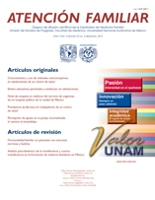Knowledge and Use of Contraceptive Methods in Adolescents of a Health Care Center
Main Article Content
Abstract
Objective: to identify the level of knowledge and use of contraceptive methods in adolescents. Methods: observational, descriptive and cross-sectional study. The study included adolescents from 15 to 19 years with an active sexual life and who attended a Health Care Center in Mexico City from September to October 2014. Non-randomized sample. The 120 adolescents self-applied the survey that included: socio-demographic variables, knowledge and use of contraceptive methods. Descriptive and inferential statistics with U of Mann-Whitney and Kruskall-Wallis tests were used. The level of significance was of 0.05, with the statistical program spss v.20. Results: 120 adolescents were interviewed whose level of knowledge was rated as average in 60.8% and low in 23.3%. The condom was the most used contraceptive method (65.2%); additionally, it was the barrier method better known (95.8%). Only there were differences regarding the age of the participants (p=0.030). Conclusions: the obtained results in this study showed that it is necessary to improve the quality of information about the correct use of contraceptive methods, which it is expected to positively impact in sexual and reproductive health.
Downloads
Download data is not yet available.
Article Details
How to Cite
Sánchez-Meneses, M. C., Dávila-Mendoza, R., & Ponce-Rosas, E. R. (2015). Knowledge and Use of Contraceptive Methods in Adolescents of a Health Care Center. Atención Familiar, 22(2). https://doi.org/10.22201/facmed.14058871p.2015.2.47989
